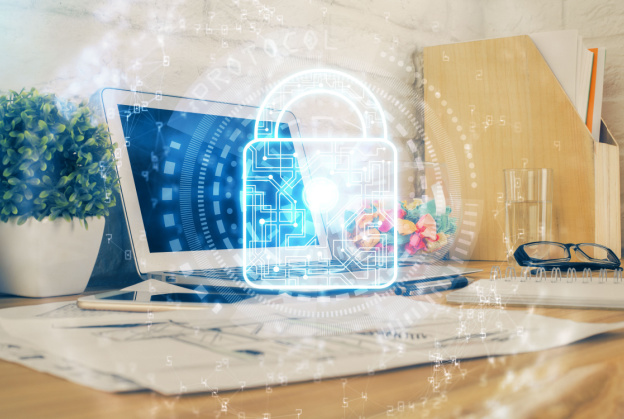In recent years, remote work has become an increasingly popular option for professionals seeking flexibility and work-life balance. The COVID-19 pandemic accelerated this trend, leading to a massive shift towards remote work for millions of individuals worldwide. However, with the rise of remote work comes a heightened need for cybersecurity measures to safeguard the home office environment. According to a March 2022 report by Alliance Virtual Offices, remote work during the COVID-19 pandemic drove a staggering 238% increase in cyber attacks. This alarming statistic highlights the urgent importance of prioritizing cybersecurity for remote workers. In this blog, we will explore the key steps and best practices for creating a secure home office environment, protecting sensitive data, and defending against the ever-evolving cyber threats faced by remote workers. By implementing these strategies, you can fortify your virtual workspace and minimize the risks associated with remote work.
Understanding the Risks of Remote Work
Remote work offers undeniable benefits, such as flexibility and convenience, but it also exposes workers to a range of unique cybersecurity risks. Without the robust security infrastructure of traditional office environments, remote workers become more vulnerable to cyber threats. One of the significant risks is the increased potential for data breaches and unauthorized access to sensitive information. Home networks and personal devices often lack the same level of security measures as corporate networks, making them attractive targets for cybercriminals. Another risk is the prevalence of phishing attacks and social engineering tactics. Remote workers are frequently targeted through deceptive emails, malicious links, or fraudulent requests, as cybercriminals exploit the potential gaps in security awareness and the distractions of working from home. These attacks can lead to compromised accounts, identity theft, or the inadvertent disclosure of confidential data. Furthermore, the use of public Wi-Fi networks in coffee shops or other shared spaces introduces additional risks, as these networks are often unsecured and prone to eavesdropping and data interception.
According to Intrusion, the Top 5 Remote Work Cybersecurity Threats for 2023 are:
- Phishing Attacks
- Credential Stuffing
- VPN Exploits
- Insecure Applications
- Ransomware Attacks
It is imperative for remote workers to recognize and understand these risks in order to take proactive measures to mitigate them. By implementing robust cybersecurity practices and staying informed about emerging threats, remote workers can better protect their home office environment and ensure the confidentiality, integrity, and availability of their work-related data.
Creating a Secure Home Office Environment
In IBM’s Cost of a Data Breach 2022 Report, researchers found that data breaches associated with remote working resulted in costs approximately $1 million higher compared to breaches where remote working was not a contributing factor. This is why ensuring the security of remote worker devices and controlling access is paramount. A comprehensive device management policy should be established, outlining guidelines for securing personal devices used for work purposes. This may involve implementing remote device tracking and wiping capabilities to safeguard sensitive data in case of loss or theft. To further control access, strong access controls and user privileges should be enforced. Multi-factor authentication (MFA) adds an extra layer of security by requiring additional credentials beyond passwords. Regularly reviewing and updating user access privileges based on job roles and responsibilities minimizes the risk of unauthorized access. Additionally, implementing monitoring and detection tools enables organizations to track network traffic, detect anomalies, and identify potential security breaches. Proactive monitoring allows for real-time identification of suspicious activities or unauthorized access attempts, facilitating immediate action. It is also crucial to establish an incident response plan for remote incidents, including reporting procedures, communication channels, and coordination with stakeholders. Conducting regular security audits and assessments helps identify vulnerabilities and gaps, enabling necessary improvements and staying ahead of emerging threats.
One essential practice to protect your home office is using a virtual private network (VPN) to establish secure and encrypted connections when accessing company resources remotely. VPNs create a private and encrypted tunnel, safeguarding data from potential eavesdropping or interception. Implementing endpoint security measures such as antivirus software, firewalls, and regular software updates is crucial in defending against malware and unauthorized access attempts. Encrypting sensitive data both in transit and at rest provides an additional layer of protection. Utilizing encryption tools and secure file-sharing methods prevents unauthorized access to confidential information. Furthermore, remote workers should remain vigilant against phishing attempts and social engineering attacks. Regular training and awareness programs educate remote workers about potential threats and help them identify and report suspicious emails, links, or requests. By following these best practices, remote workers can significantly enhance the security of their home office environment and mitigate the risks associated with remote work.
As remote work continues to rise in popularity, the need for robust cybersecurity measures to safeguard the home office environment becomes increasingly crucial. By implementing best practices such as comprehensive device management, strong access controls, multi-factor authentication, and proactive monitoring, remote workers can fortify their home office environments and mitigate risks. Creating a secure home office involves utilizing VPNs, endpoint security measures, encryption, and staying vigilant against phishing attempts. With these measures in place, remote workers can still embrace the benefits while also effectively protecting themselves and their organizations from cybersecurity threats.




